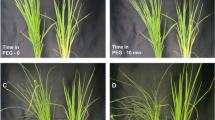Abstract
The development of gas-filled root porosity in response to temporary low oxygen supply was tested for a range of edible and ornamental crops: rice, maize, wheat, sugar beet, tomato, cucumber, sweet pepper, carnation, gerbera and rose. In a first experiment, the roots of tomato, maize and gerbera had a higher gas-filled root porosity, Ep (% v/v), when grown permanently in a non-aerated instead of aerated solution. The Ep of roots increased during two weeks when half the root system of a young plant was transferred to a non-aerated solution; in older plants this response was not seen. Carnation had a negligible gas-filled porosity in all treatments. In a second experiment, a comparison was made between high (20 kPa) and low (about 2 kPa) O2 partial pressure in a recirculating nutrient solution. Half of the root system was transferred to low O2 at various growth stages. In most species older plants did not increase Ep on exposure to low O2. For tomato, sweet pepper and rose, Ep was normally in the range 3–8% (v/v). Young plants of cucumber, wheat and sugar beet also had an Ep in that range, but in older plants values ranged from 1 to 3%. Transverse root sections examined by light microscopy showed, on average, 60% more intercellular spaces in the root cortex than the measurements of gas-filled porosity, probably because some gaps and spaces in the cortex were not gas-filled. This effect was most pronounced in tomato. A negative pressure in the cortex may be needed for gaps to be gas-filled. An exodermis may increase the effectiveness of gas spaces in the cortex by closing the gas channels and, by offering some resistance to water uptake, allowing a negative pressure head in the cortex which keeps gaps gas-filled. A redox dye method was developed to study the length of root which is effectively supplied with oxygen, as a function of Ep. Results indicated that for every percent Ep the root can remain aerated over at least 1 cm in a non-aerated medium under the conditions of the test.
Similar content being viewed by others
References
Armstrong W 1971 Radial oxygen losses from intact rice roots as affected by the distance from the apex, respiration and waterlogging. Physiol. Plant. 25, 192–197.
Armstrong W 1972 A re-examination of the functional significance of aerenchyma. Physiol. Plant. 27, 173–177.
Boone F R and Veen B W 1993 Mechanisms of crop responses to soil compaction. In Soil Compaction in Crop Production. Eds. B D Soane and C Van Ouwerkerk. Elsevier, Amsterdam, (In press).
Brouwer R 1981 Co-ordination of growth phenomena within a root system of intact maize plants Plant and Soil 63, 65–72.
Cannell R Q and Belford R K 1980 Effects of waterlogging at different stages of development on the growth and yield of winter oilseed rape (Brassica napus L.). J. Sci. Food and Agric. 31, 963–969.
Crawford R M M 1982 Physiological responses to flooding. Encycl. of Plant Physiol. N.S. 12B, pp 453–478.
Crawford R M M 1989 Studies in Plant Survival, Ecological Case Histories of Plant Adaptation to Adversity. Blackwell Scient. Publ., Oxford. 296 p.
Danilova M F, Serdjuk H M and Kharitonova T M 1992 The lateral root initiation and transport of nutrients. In Root Ecology and its Practical Application Eds. L Kutschera, E Hübl, E Lichtenegger, H Persson and M Sobolik. pp 29–32. 3rd ISRR Symp. Wien 1991, Verein für Wurzel-forschung, A-9020 Klagenfurt.
De Willigen P and Van Noordwijk M 1989 Model calculations on the relative importance of internal longitudinal diffusion for aeration of roots of non-wetland plants. Plant and Soil 113, 111–119.
Drew M C 1983 Plant injury and adaption to oxygen deficiency in the root environment: A review. Plant and Soil 75, 179–199.
Drew M C 1990 Sensing soil oxygen. Plant Cell and Environ. 13, 681–693.
Drew M C, Jackson M B and Giffard S 1979 Ethylene-promoted adventitious rooting and development of cortical air spaces (aerenchyma) in roots may be adapted responses to flooding in Zea mays L. Planta 147, 83–88.
Jackson M B, Blackwell P S, Chrimes J R and Sims T V 1984 Poor aeration in NFT and a means for its improvement. J. Hortic. Sci. 59, 439–448.
Jensen C R Luxmoore R J, Grundy S D and Stolzy L H 1969 Root air space measurements by a pycnometer method. Agron. J. 61, 474–475.
Justin S H F W and Armstrong W 1987 The anatomical characteristics of roots and plant response to soil flooding. New Phytol. 106, 465–495.
Konings H 1983 Formation of gas spaces (Aerenchyma) in seeding roots of Zea mays under aerated and non-aerated conditions. In Wurzelökologie und ihre Nutzanwendung. Eds. W. Böhm, L Kutschera and E Lichtenegger pp 761–765. Int. Symp. Gumpenstein 1982, Irdning.
Laan P, Smolders A, Blom C W P M and Armstrong W 1989 The relative roles of internal aeration, radial oxygen losses, iron exclusion and nutrient balances in flood tolerance of Rumex species. Acta Bot. Neerl. 38, 131–145.
Lambers H 1987 Growth, respiration, exudation and symbiotic association: The fate of carbon translocated to the roots. In Root Development and Function. Eds P J Gregory, J V Lake and D A Rose. pp 125–145. Cambridge University Press, Cambridge.
Luxmoore R J, Stolzy L H and Letey J 1970 Oxygen diffusion in the soil plant system. I. A model. Agron. J. 62, 317–322.
Nieuwenhuizen W N 1984 System induced variations in oxygen uptake by submerged tomato roots and their possible effects on ethylene biosynthesis, foliar degeneration, root browning and root death. In Proc. 6th Intern. Congress on Soilless Culture, Lunteren, April–May 1984. pp 447–464. ISOSC, Wageningen.
Sperry J S and Tyree M T 1990 Water-stress-induced xylem embolism in three species of conifers. Plant Cell Environ. 13, 427–436.
Sperry J S, Perry A H and Sullivan J E M 1991 Pit membrane degradation and air-embolism formation in ageing xylem vessels of Populus Tremuloides Michx. J. Exp. Bot. 42, 1399–1406.
Trolldenier G 1988 Visualisation of oxidizing power of rice roots and if possible participation of bacteria in iron deposition. Z. Pflanzenernaehr. Bodenkd. 151, 117–121.
Vestergaard B 1984 Oxygen supply to the roots in different hydroponic systems. In Proc. 6th Intern. Congress on Soilless Culture, Lunteren, April–May 1984. pp 723–738. ISOSC, Wageningen.
Van Noordwijk M and Brouwer G 1988 Quantifiction of air-filled root porosity: A comparison of two methods. Plant and Soil 111, 255–258.
Van Noordwijk M, Brouwer G and Harmanny K 1993 Concepts and methods for studying interactions of roots and soil structure. Geodermal 56, 351–375.
Van Raalte M H 1944 On the oxidation of the environment by the roots of rice (Oryza sativa L.) Ann. Bot. Gard. Buitenzorg, Hors Serie 15, 15–34.
Veen B W, Van Noordwijk M, De Willigen P, Boone F R and Kooistra M J 1992 Root-soil contact of maize, as measured by thin-section technique. III. Effects on shoot growth, nitrate and water uptake efficiency. Plant and Soil 139, 131–138.
Waters I, Kuiper P J C, Watkin E and Greenway H 1991 Effects of anoxia on wheat seedlings. I. Interaction between anoxia and other environmental factors. J. Exp. Bot. 42, 1427–1435.
Wiedenroth E M 1993 Responses of roots to hypoxia: Their structural and energy relations with the whole plant. Environm. and Experim. Bot. 33, 41–51.
Zhang B G, Puard M and Couchat P 1990 Effect of hypoxia, acidity and nitrate on inorganic nutrition in rice plants. Plant Physiol. Biochem. 28, 655–661.
Author information
Authors and Affiliations
Rights and permissions
About this article
Cite this article
Van Noordwijk, M., Brouwer, G. Gas-filled root porosity in response to temporary low oxygen supply in different growth stages. Plant Soil 152, 187–199 (1993). https://doi.org/10.1007/BF00029088
Received:
Accepted:
Issue Date:
DOI: https://doi.org/10.1007/BF00029088




